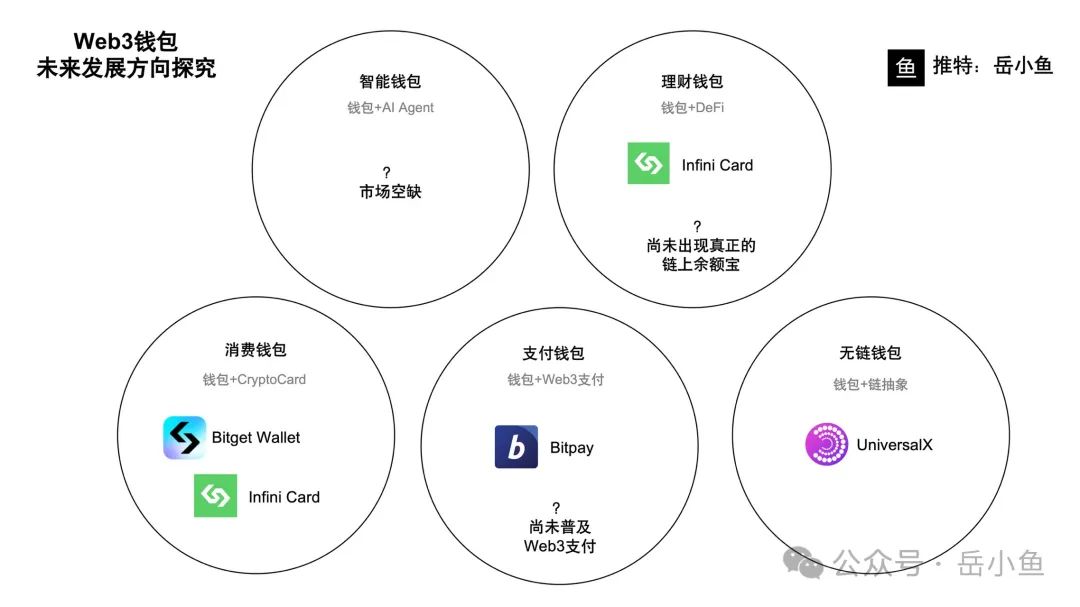Only by deeply understanding the user’s usage scenarios can we truly understand the user’s needs and provide users with the products they really need.
Written by: Yue Xiaoyu

As a Web3 Wallet product manager and a direct practitioner of the Web3 Wallet Track, I design various functions by myself every day and perceive the real needs of users on the front line.
But in addition to immersing yourself in doing things, you also need to look up and look at the road; in addition to micro practical operations, you also need macro perception so that you can go further.
I have always believed that Wallet Track is an important infrastructure and a high ceiling track. Wallet is the entrance to the Web3 world. After mastering traffic, you can do many things.
Nowadays, the wallet track is also surging, and the competition is extremely fierce. There are old wallets such as Metamask and TokenPocket, and then there are Web3 wallets made by exchanges that have invested a lot of resources. Now there are wallets cut in from many segmented scenarios, typical examples are Particle Network’s chain abstract wallet.
It seems that the form of wallets is now very homogeneous, so how can new wallet products establish their own differentiated competitive advantages? What will the future shape of the Web3 wallet look like?
The Web3 wallet war has entered the second half.
Here, based on my perceived user needs, latest technology trends, and market development directions, I will take a detailed account of the possible future development directions of Web3 wallet.

Direction 1: Wallet +AI Agent= Smart Wallet
The combination of AI Agents and blockchain wallets can realize the transformation from ordinary wallets to smart wallets.
Today’s wallets are still too simple. They are completely the “function machines” of the past, with only basic functions such as making calls and sending text messages.
But after superimposing the capabilities of AI, is it possible to make existing wallets leap into the era of smart wallets?
Combined with AI technology, wallets are not just a tool for asset storage, but become an intelligent system that can proactively help users manage funds, optimize investments, improve security, and provide personalized services.
This allows the functionality of the wallet to be greatly enhanced, thereby realizing the transformation from a normal wallet to a smart wallet.
The combination of AI Agents and wallets will completely subvert the interaction methods of existing wallets.
I hope that the future wallet track will usher in the “Apple Moment”!
Direction 2: Wallet +DeFi= Financial wallet
Asset management is the first step. When user funds are deposited into applications, the greater value lies in financial management.
There are three core requirements of the Web3 industry: asset issuance, asset trading and asset management.
The progressive relationship between these three is that the problem of asset issuance is solved first, after the assets are available, transactions are needed, and easy-to-use trading tools are needed, and then users need easy-to-use asset management tools.
In asset management, in addition to basic asset custody, what is more important is the opportunity for asset appreciation, that is, financial management.
Users hope that interest can be earned on their spare funds without playing DeFi or trading.
It is best to use the simplest method to earn interest, such as recharging ETH or stable coins. Interest can be automatically earned without additional operations, but it can be used at any time, similar to Yu ‘ebao.
Users need a real online balance treasure!
Compared with Alipay’s current size, the ceiling of the financial wallet is very high, which can not only drive a large amount of assets to deposit, but also bring stable and high benefits to the wallet platform itself.
Direction 3: Wallet +Crypto Card= Consumer Wallet
Crypto Card, an encrypted bank card, can also be called a U card. You can recharge stablecoins such as USDT/USDC. You can bind it to Weixin Pay for daily use without withdrawing money.
Doing Crypto Card business in wallet is a very good combination.
Crypto Card directly solves the biggest pain point in the currency circle: withdrawing money.
Because it is very easy to receive black money, withdrawals are very easy to be blocked. Withdrawal is more difficult than deposit, and the wear and tear is also greater. The basic handling fee for some stable and reliable withdrawal channels is about 6%.
After the emergence of Crypto Card, it directly solved the problem of small withdrawals by people in the currency circle. This card can be directly bound to third-party payment channels (such as Weixin Pay) for daily consumption, and will be regarded as a normal foreign currency card in China.
The Crypto Card is essentially a prepaid card. The card issuer has a bank account with Visa/MasterCard. The user transfers the stablecoin to the card issuer, and the card issuer will give you the card payment limit. It is similar to the recharge card issued by the supermarket. It can only be used for payment and cannot be transferred. There is actually no legal currency balance in this card.
The deposit and withdrawal business generally cooperates with OTC service providers and has high requirements for KYC. Crypto Card is a good supplement. It can withdraw small amounts in disguise, and the profit margin is not low. Therefore, it is a good business direction for wallets and has synergy effects.
Bitget Wallet currently has Crypto Card related services built into its wallet.
One of the most popular brands recently is Infini Card. This card can stand out among all U cards. One of the core secrets is that it combines financial management scenarios. Users can charge U in it, not only for consumption, but also get 7% of the annualized income without other operations, realizing the ability of “on-chain balance treasure” in disguise.
Direction 4: Wallet + Web3 Payment = Payment Wallet
Payment is a very high-frequency service, and naturally it is very imaginative.
However, the biggest problem facing Web3 payment currently is actually the lack of scenarios. Just like the rise of online payment in Web2, it was also due to the vigorous development of e-commerce.
It is precisely because of Taobao that the demand for electronic payments has arisen, and products like Alipay have emerged.
If Web3 payments want to be popularized on a large scale, what they need is a killer application scenario, so that the unique potential of blockchain payments can be realized.
At present, in the consumption scenarios of C-end users, the popularity of Web3 payments is still far from being popular, so making payments in wallets seems to have low priority.
However, Binance and OKX have now made some attempts. For example, Binance has launched Binance Pay and cooperated with some merchants. In some scenarios, when paying, the card can invoke Binance APP with one click. The experience is very similar to the Web2 payment application of Alipay; OKX directly starts from the consumption scenario and builds the OKX House e-commerce platform in OKX Web3 Wallet. When you buy things on this platform, you can directly use it to invoke payment.
In fact, in addition to payment in the C-side scenario, there are also payment in the B-side scenario. This scenario is more mature, such as cross-border payment, merchant collection, etc. These scenarios are currently satisfied by some enterprise-level wallet service providers, such as Cobo and Fireblocks.
Direction 5: Wallet + chain abstraction = chainless wallet
Ordinary users have only one demand for Web3 wallets: whether they can make surfing online more convenient.
However, most wallets are not good enough nowadays. Ordinary users need to understand many concepts before they can truly use them, such as understanding private keys, understanding Gas, understanding cross-chain, etc.
Although many wallets have smoothed out the differences between different chains as much as possible at the application level and tried to provide users with a unified experience, a typical example is OKX wallet, which aggregates a lot of chains, DEXs and cross-chain bridges, and can be completed in one stop. These operations.
However, this does not fundamentally solve the problem, and various concepts based on blockchain characteristics still need to be understood by users.
There is a bold and radical approach: to completely reinvent the current user experience and change the user interaction model that seems to have become an “industry paradigm.”
The complexity of wallets now lies in the concept of “chain”. There are too many chains now, and more packaging should be made at the product level to provide a completely different product experience.
In this scenario, you can consider combining “chain abstraction”, which is to encapsulate the concept of chain, so that users do not have to perceive the concept of chain, the existence of Gas token, and the need to cut and cross chains, and use a universal token to pay for all chains. The handling fee is enough.
This is truly in line with the common experience of Web2 applications for novice Xiaobai users.
At present, the one that is very advanced is Particle Network. Looking at the development history of Particle Network, from wallet abstraction to account abstraction to chain abstraction, its product development is very focused and has developed vertically and deeply in wallet technical services.
The overall iteration is step-by-step based on existing users and products, solving problems at different stages, and integrating many cutting-edge narratives of the Web3 industry.
Today, Particle Network has expanded to decentralized exchange business. UniversalX is actually an exchange form, chain abstraction +DEX+ private key wallet.
In the future, chain abstraction should become a basic component and become a standard feature of various products.
summarize
The five types of wallets in these five directions are not clearly differentiated. A wallet does not only have one direction and only has one attribute. It often spans several attributes.
So how to catch users?
Here is a quote from the OKX Wallet product manager said at the OKX New Year’s Eve dinner sharing meeting:Dig deep into scenarios, users come first。
Requirements are based on scenarios. Only by deeply understanding the user’s usage scenarios can we truly understand the user’s needs and provide users with the products they really need.
Welcome to join the official social community of Shenchao TechFlow
Telegram subscription group: www.gushiio.com/TechFlowDaily
Official Twitter account: www.gushiio.com/TechFlowPost
Twitter英文账号:https://www.gushiio.com/DeFlow_Intern



